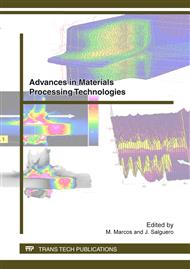p.91
p.97
p.103
p.109
p.115
p.121
p.127
p.133
p.139
Flank Wear and Surface Roughness Estimation in Steel Turning
Abstract:
This paper presents a method to detect tool wear and surface roughness during steel dry turning. It is important to note that the objective of the proposed method is to fulfill the needs in the development of these monitoring systems according with the research community in this area, and they are: 1) A trade-off between the number of sensors used and their cost, and the performance of the monitoring system, 2) A sufficiently reduced computing time that allows to change the tool before the wear exceeds the fixed threshold and/or stop the machining process before the surface roughness exceeds its threshold, and 3) The use of sensors that do not disturb the machining process. The monitoring signals are the feed motor current and the vibrations. The results show that the proposed system can be used for this purpose due to its high accuracy and reliability.
Info:
Periodical:
Pages:
115-120
Citation:
Online since:
April 2012
Authors:
Keywords:
Price:
Сopyright:
© 2012 Trans Tech Publications Ltd. All Rights Reserved
Share:
Citation:


